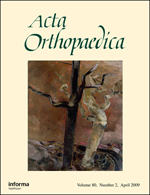
Arthroplasty
Less periprosthetic bone loss with ultra-short stem vs conventional stem in THA at 2 years
Acta Orthop. 2015 Dec;86(6):659-6651 patients with osteoarthritis undergoing total hip arthroplasty were randomized to receive either an uncemented conventional tapered stem or an uncemented ultra-short stem. The purpose of this randomized controlled trial was to compare the different stems in terms of periprosthetic bone loss in the proximal femur, safety, and migration, at 2 years postoperatively. The results suggested that the decrease in periprosthetic bone mineral density (Gruen zone 1 and 1-7) was significantly lower in the ultra-short stem patients. During the first 6 postoperative weeks, the ultra-short stem group displayed greater implant migration, which remained significant at 2 years. Between groups, clinical outcomes were similarly improved at 2 years and adverse events were comparable.
Unlock the full article
Get unlimited access to OrthoEvidence with a free trial
Start TrialCritical appraisals of the latest, high-impact randomized controlled trials and systematic reviews in orthopaedics
Access to OrthoEvidence podcast content, including collaborations with the Journal of Bone and Joint Surgery, interviews with internationally recognized surgeons, and roundtable discussions on orthopaedic news and topics
Subscription to The Pulse, a twice-weekly evidence-based newsletter designed to help you make better clinical decisions
Exclusive access to original content articles, including in-house systematic reviews, and articles on health research methods and hot orthopaedic topics
Or continue reading this full article
Register Now

Subscribe to "The Pulse"
Evidence-Based Orthopaedics direct to your inbox.




































